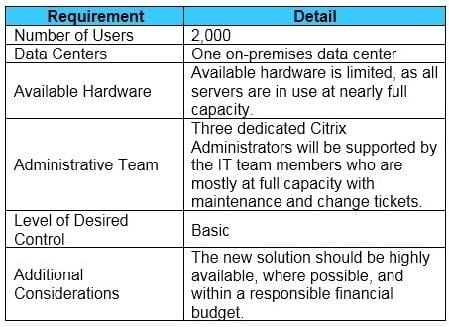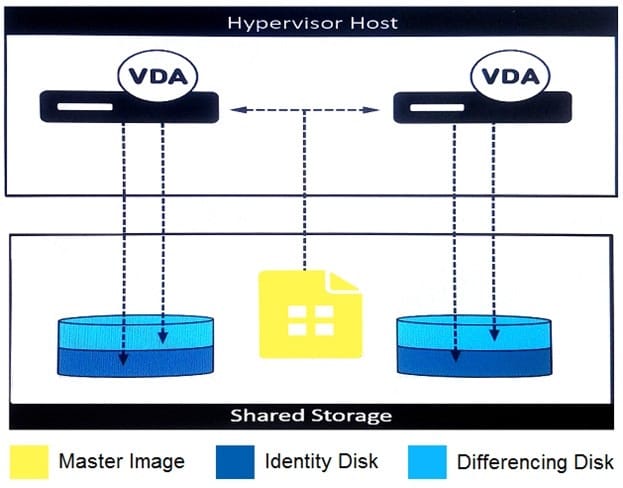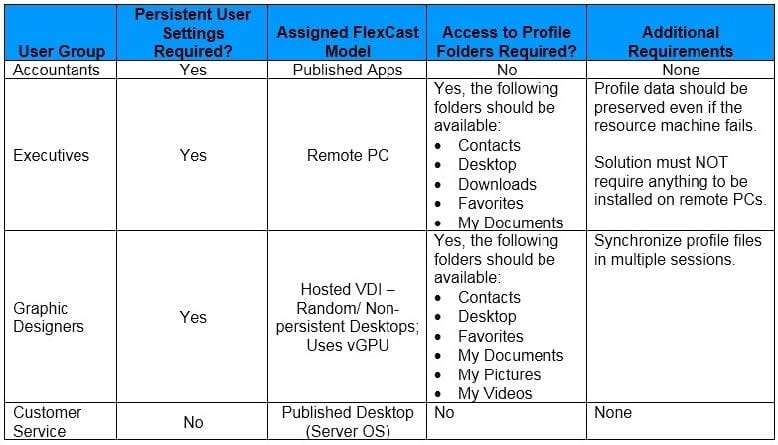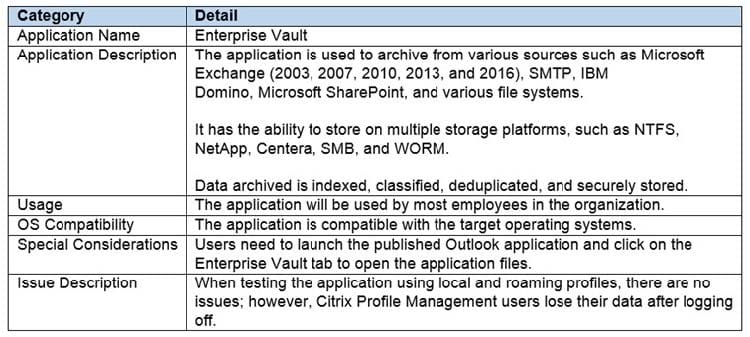1Y0-403 Online Practice Questions and Answers
Scenario: The IT team of a company configured its Citrix environment on Microsoft Azure. Load on the servers is nominal during the off season, but during peak season, load increases on the infrastructure servers. This load varies from year to year. A Citrix Architect is asked to design a solution that dynamically increases and decreases the number of infrastructure servers.
What should the architect recommend the IT team create in Microsoft Azure to meet this demand?
A. Availability sets
B. Resource group
C. Scale sets
D. Availability domains
Scenario: An infrastructure team has stated that the new Citrix Virtual Apps and Desktops virtualization host will have the specifications shown in the exhibit.
Click the Exhibit button to view the specifications.

The design document calls for the VMs to have 2 CPUs and 4 GB RAM. Approximately how many virtual desktops can be hosted an each physical server?
A. 190
B. 240
C. 120
D. 60
Scenario: A Citrix Architect is creating a conceptual architecture for a Citrix Virtual Apps and Desktops environment. Based on some initial the company's business goals and objectives, the architect has collected the information shown in the exhibit.
Click the Exhibit button to view the information.

Which delivery model should the architect recommend?
A. Single-Site in Citrix Cloud, public cloud, and on-premises resource locations
B. Multi-Site, multi-zone, and multiple on-premises data centers
C. Multi-Site in Citrix Cloud, and multiple public cloud resource locations
D. Single-Site, single-zone, and single on-premises data center
Scenario: A Citrix Architect is redesigning a Citrix Virtual Apps and Desktops environment to include Machine Creation Services (MCS). During design discussions, the locations for the MCS-provisioned thin clone machine disks are proposed as shown in the exhibit.
Click the Exhibit button to view the details.

Which two potential issues should the architect address with the customer before proceeding with this configuration? (Choose two.)
A. It is limited to certain hypervisors.
B. It will require substantial write IOPS to the shared storage location as temporary data is written.
C. It is limited to NFS shared storage.
D. It will require substantial read IOPS from the shared storage location during machine creation and updates.
E. It will require more storage to be allocated on the virtual machine (VM) hosts compared with other options.
Scenario: A Citrix Architect needs to design a new Citrix Virtual Apps and Desktops environment.
Click the Exhibit button to view information collected by the architect during the Resource Layer discussions.

Based on the requirements, the Citrix Administrative team should use _____________ to manage Citrix policies and _____________ to manage Microsoft settings. (Choose the correct option to complete the sentence.)
A. Citrix Studio; Active Directory Group Policy Objects
B. Active Directory Group Policy Objects; Workspace Environment Manager
C. Citrix Studio; Workspace Environment Manager
D. Citrix Studio; Local policies
E. Active Directory Group Policy Objects; Active Directory Group Policy Objects
Scenario: A Citrix Architect is designing a new Citrix Virtual Apps and Desktops environment. The architect has identified the Resource Layer requirements shown in the exhibit.
Click the Exhibit button to view the requirements.

Which feature of Citrix Profile Management could help the architect address the Graphic Designers Group requirements?
A. Active write back
B. NTUser.dat backup
C. Profile streaming
D. Profile caching
Scenario: An automobile manufacturer in Germany has deployed a Citrix Virtual Apps and Desktops solution for its employees using Citrix Cloud and uses a resource location in Germany. Recently, they acquired an automobile manufacturer in Japan. Since then, users from Japan have reported issues regarding slowness and degraded performance of the application hosted in the German resource location.
How can a Citrix Architect improve the performance of the application for users in Japan?
A. Implement Optimal Gateway Routing within the existing resource location.
B. Create a new Site for Japan within Germany's resource location
C. Provision new resources in Japan's resource location
D. Implement Global Server Load Balancing (GSLB)
Scenario: A Citrix Architect is designing a new Citrix Virtual Apps and Desktops environment. The architect's objective is to create a configuration to automatically reroute network traffic to the second NIC within the bond. The goal is to avoid a loss of productivity should the primary Citrix Hypervisor host NIC fail. Each hypervisor currently consists of a single, active 10 GB NIC and a second, dormant 1 GB NIC.
Which two network interface configurations should the architect implement? (Choose two.)
A. Active-passive (LACP)
B. Active-active (SLB)
C. NIC teaming-bonding
D. Active-active (LACP)
Scenario: A Citrix Architect is designing a Citrix Virtual Desktops environment. The Graphic Designers Group uses graphic-intensive applications. Graphic designers will be provided with a Windows 10-hosted assigned desktop, with NVIDIA graphics hardware acceleration. HDX 3D Pro mode was selected during the installation of the Virtual Delivery Agent (VDA).
What is the maximum number of monitors supported for the Graphic Designers Group?
B. 1
C. 2
D. 8
Scenario: A Citrix Architect needs to manage the disaster recovery (DR) process for a Citrix Virtual Apps and Desktops environment. The environment currently consists of an active data center typically accessed by users, and a DR data center used in the event that a disaster impacts the primary data center. Management has made it a priority to minimize the loss of data when failing over between data centers.
The environment has failed over from the primary data center to the DR data center and the primary data center has subsequently been recovered to its normal state.
What is the appropriate sequence of steps that the architect should follow to return to normal operations after the primary data center's stability is confirmed?
A. Complete replication to the primary data center, block access to the DR data center, terminate/drain existing sessions in the DR data center, configure replication back to the DR data center, and enable access in the primary data center.
B. Terminate/drain existing sessions in the DR data center, complete replication to the primary data center, block access to the DR data center, enable access in the primary data center, and configure replication back to the DR data center.
C. Block access to the DR data center, terminate/drain existing sessions in the DR data center, complete replication to the primary data center, configure replication back to the DR data center, and enable access in the primary data center.
D. Block access to the DR data center, complete replication to the primary data center, terminate/drain existing sessions in the DR data center, enable access in the primary data center, and configure replication back to the DR data center.
E. Terminate/drain existing sessions in the DR data center, block access to the DR data center, complete replication to the primary data center, configure replication back to the DR center, and enable access in the primary data center.
F. Complete replication to the primary data center, terminate/drain existing sessions in the DR data center, block access to the DR data center, enable access in the primary data center, and configure replication back to the DR data center.
Scenario: A Citrix Architect is designing a new Citrix Virtual Apps and Desktops Service environment in Citrix Cloud. The customer previously installed all applications locally on managed laptops and desktops, but is willing to evaluate other application delivery methods as part of the new deployment. The environment will be standardized on Windows 10 and Windows Server 2016 for the Virtual Delivery Agent (VDA) machines.
As part of an application analysis performed earlier in the project, the information in the exhibit was collected regarding 1 of the required applications. Click the Exhibit button to view the information.

The customer has the additional objective of minimizing authentication cycles for users with no configuration efforts on user machines.
How should the architect publish the application?
A. Through the Citrix Gateway Service as a Web/SaaS application
B. Through Citrix Gateway as a Web/SaaS application
C. As a streamed application using Microsoft App-V
D. From Citrix Virtual Apps and Desktops Service
Scenario: A Citrix Architect deployed a new Citrix Virtual Desktops environment in Citrix Cloud. The environment is accessed exclusively by users in a location where Citrix Cloud does NOT have a local point of presence (POP). The Corporate Security team advises that a new industry regulation requires that all user HDX-session communications remain within the country.
In addition, users have requested file-type-association functionality to launch published applications from within their virtual desktops.
What should the architect configure for this deployment?
A. On-premises Citrix Gateway with on-premises StoreFront
B. Citrix Cloud-hosted Gateway Service with Citrix Cloud-hosted Workspace
C. On-premises Citrix Gateway with Citrix Cloud-hosted Workspace
D. Citrix Cloud-hosted Gateway Service with on-premises StoreFront
Scenario: A Citrix Architect is designing a new Citrix Virtual Apps and Desktops environment. The architect has identified the Resource Layer requirements shown in the exhibit.
Click the Exhibit button to view the requirements.

Which Citrix Profile Management configuration could help the architect address the issue referenced in the exhibit?
A. Enable Cross-platform
B. Add the application folder to the Inclusion policy
C. Add the application folder to the Exclusion policy
D. Enable Active write back
Scenario: A Citrix Architect is designing a Citrix Virtual Apps and Desktops environment. The company has a small IT team with limited experience deploying and maintaining this type of environment.
To perform adequately, the line of business application used by the company must be hosted <10ms RTT from a backend database located within a customer-managed data center.
Which Citrix Virtual Apps and Desktops environment best meets the needs of this organization?
A. Citrix Virtual Apps and Desktops and Microsoft Azure workload
B. Citrix Virtual Apps and Desktops Service and on-premises workload
C. Citrix Virtual Apps and Desktops Service and Microsoft Azure workload
D. Citrix Virtual Apps and Desktops and on-premises workload
Scenario: A Citrix Architect is creating a conceptual architecture for a Citrix Virtual Apps and Desktops environment. Based on some initial discussions around the company's business goals and objectives, the architect collected the information shown in the exhibit.
Click the Exhibit button to view the information.

Which delivery model should the architect recommend?
A. Single-Site in Citrix Cloud, with resources hosted in public cloud
B. Single-Site, single-zone, and single on-premises data center
C. Multi-Site, and single on-premises data center
D. Multi-Site in Citrix Cloud, with resources hosted in public cloud
